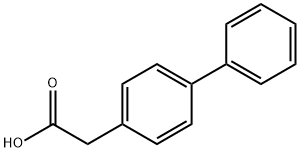All AbMole products are for research use only, cannot be used for human consumption.

4-Biphenylacetic acid (BPA) is a potential non-steroidal anti-inflammatory agent and forms solid inclusion complex with β-cyclodextrin. Its interaction with quinolone antibacterial agents can induce functional blockade of the γ-aminobutyric acid receptors.

Int J Biol Macromol. 2023 Dec 31;253(Pt 8):127501.
Bisphenol A exposure exacerbates tracheal inflammatory injury in selenium-deficient chickens by regulating the miR-155/TRAF3/ROS pathway
4-Biphenylacetic acid purchased from AbMole

Molecules. 2023 Apr 7.
Study of the Sensing Kinetics of G Protein-Coupled Estrogen Receptor Sensors for Common Estrogens and Estrogen Analogs
4-Biphenylacetic acid purchased from AbMole
| Molecular Weight | 212.24 |
| Formula | C14H12O2 |
| CAS Number | 5728-52-9 |
| Solubility (25°C) | DMSO 42 mg/mL |
| Storage |
Powder -20°C 3 years ; 4°C 2 years In solvent -80°C 6 months ; -20°C 1 month |
| Related Immunology/Inflammation Products |
|---|
| 3-Fucosyllactose
3-Fucosyllactose (3-Fucosyl-D-lactose) is one of the major fucosylated oligosaccharides found in human breast milk. 3-Fucosyllactose shows prebiotic, immunomodulator, neonatal brain development, and antimicrobial function. |
| Aloe Polysaccharide
Aloe Polysaccharides are the primary bioactive components of aloe vera gel, primarily found in the gel-like portion of the aloe vera leaf, specifically the transparent, viscous section enclosed by the leaf epidermis. Aloe polysaccharides are a large class of macromolecular compounds with diverse physiological functions, primarily composed of mannose, galactose, glucose, xylose, arabinose, and rhamnose, with mannose, galactose, and glucose being the most abundant. They exhibit various bioactivities, including antibacterial and anti-inflammatory effects, antiviral activity, immune modulation, antitumour properties, radiation protection, antioxidant properties, and hypoglycaemic effects. |
| Terminalia Chebula Extract
Terminalia Chebula Extract is extracted from Terminalia Chebula, which has antioxidant, hepatoprotective, neuroprotective, cytotoxic, antidiabetic, and anti-inflammatory activities. |
| SMS121
SMS121 is a novel CD36 inhibitor. SMS121 reduced the uptake of fatty acid into AML cells that could be reversed by addition of free fatty acids and caused decreased cell viability. |
| Rolistobart
Rolistobart is a humanized immunoglobulin G4-kappa, anti-LILRB4/CD85k monoclonal antibody. |
All AbMole products are for research use only, cannot be used for human consumption or veterinary use. We do not provide products or services to individuals. Please comply with the intended use and do not use AbMole products for any other purpose.


Products are for research use only. Not for human use. We do not sell to patients.
© Copyright 2010-2024 AbMole BioScience. All Rights Reserved.
